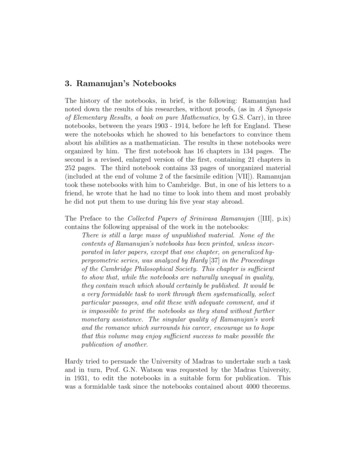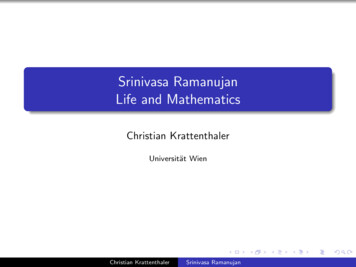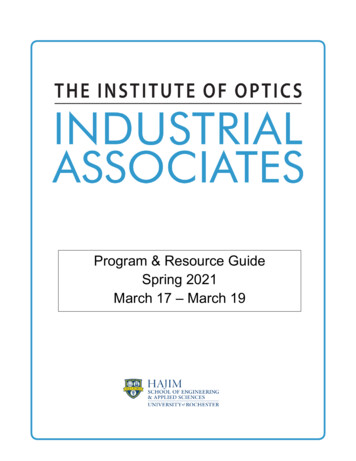
Transcription
3. Ramanujan’s NotebooksThe history of the notebooks, in brief, is the following: Ramanujan hadnoted down the results of his researches, without proofs, (as in A Synopsisof Elementary Results, a book on pure Mathematics, by G.S. Carr), in threenotebooks, between the years 1903 - 1914, before he left for England. Thesewere the notebooks which he showed to his benefactors to convince themabout his abilities as a mathematician. The results in these notebooks wereorganized by him. The first notebook has 16 chapters in 134 pages. Thesecond is a revised, enlarged version of the first, containing 21 chapters in252 pages. The third notebook contains 33 pages of unorganized material(included at the end of volume 2 of the facsimile edition [VII]). Ramanujantook these notebooks with him to Cambridge. But, in one of his letters to afriend, he wrote that he had no time to look into them and most probablyhe did not put them to use during his five year stay abroad.The Preface to the Collected Papers of Srinivasa Ramanujan ([III], p.ix)contains the following appraisal of the work in the notebooks:There is still a large mass of unpublished material. None of thecontents of Ramanujan’s notebooks has been printed, unless incorporated in later papers, except that one chapter, on generalized hypergeometric series, was analyzed by Hardy [37] in the Proceedingsof the Cambridge Philosophical Society. This chapter is sufficientto show that, while the notebooks are naturally unequal in quality,they contain much which should certainly be published. It would bea very formidable task to work through them systematically, selectparticular passages, and edit these with adequate comment, and itis impossible to print the notebooks as they stand without furthermonetary assistance. The singular quality of Ramanujan’s workand the romance which surrounds his career, encourage us to hopethat this volume may enjoy sufficient success to make possible thepublication of another.Hardy tried to persuade the University of Madras to undertake such a taskand in turn, Prof. G.N. Watson was requested by the Madras University,in 1931, to edit the notebooks in a suitable form for publication. Thiswas a formidable task since the notebooks contained about 4000 theorems.
3. Ramanujan’s NotebooksiiProf. Watson gave a lecture [39] on Ramanujan’s notebooks at the LondonMathematical Society in 1931, and published several papers between 1928–36, motivated by Ramanujan’s work. Watson’s Presidential address to theLondon Mathematical Society, in 1935, was on mock-theta functions, discovered by Ramanujan during the period when he was terminally ill (March1919 – April 1920) after his return to India. Watson undertook the task ofediting the notebooks with Prof. B.M. Wilson andthey focussed their attention on the second notebook. Chapters2–13 were to be edited by Wilson, and Watson was to examinechapters 14–21. Unfortunately, Wilson passed away prematurelyin 1935 at the age of 38. (Berndt [40]).This possibly put an end to the joint effort of Watson and Wilson to edit thenotebooks.In 1957, with monetary assistance from Sir Dadabai Naoroji Trust, at theinstance of Prof. Homi J. Bhabha and Prof. K. Chandrasekaran of the TataInstitute of Fundamental Research, the Tata Institute published a facsimileedition of the notebooks of Ramanujan in two volumes. The reproductionis thoroughly faithful to the original. About a thousand copies were madethen and in the centenary year of Ramanujan’s birth, 1987, Springer - Narosareprinted the same.The formidable task of truly editing the notebooks –viz. to either prove eachof the results or provide references to the literature where the proofs maybe found – which was started by G. N. Watson and B. M. Wilson but nevercompleted, was taken up in right earnest by Prof. Bruce C. Berndt, who hasbeen publishing a series of papers, since 1981, by himself or in collaborationwith others, including Indian Mathematicians Padmini T. Joshi, C. Adigaand S. Bhargava. He has also utilized the earlier work of G.N. Watson andB.M. Wilson on the notebooks with the Trinity College. This dedicated workof Berndt, published by Springer-Verlag [VIII], is now available in five parts,the first of which appeared in 1985 and the fifth, in 1997.At the beginning of his work, in Part I, Berndt [34] points out:The notebooks were originally intended primarily for Ramanujan’sown personal use and not for publication . Some of Ramanujan’s incorrect ‘theorems’ in number theory found in his letters to
3. Ramanujan’s NotebooksiiiHardy have been well publicized. Thus, perhaps, some think thatRamanujan was prone to making errors. However, such thinkingis erroneous. The notebooks contain scattered errors. Especiallyif one takes into account the roughly hewn nature of the material and his frequently formal arguments, Ramanujan’s accuracyis amazing.Resurgence of interestAfter Ramanujan returned to India, though he was seriously ill and bedriddenfor most of the time, he was working continuously. His life-long habit hadbeen to work on a slate and transfer the final results to the notebook or sheetsof paper. His brother-in-law has stated [59] that a vast quantity of paperscontaining his notes was handed over to the University after his death. Threedays after Ramanujan died, his brother S. Lakshminarasimhan, in a letter toProf. Hardy, dated 29th April 1920, informing him about his demise, wrote :All his Mss that were in his trunk were handed over on the day ofhis death to Mr. Ramachandra Row’s son in law, since the formeris at Nilgiris. Not only those but also the journals, magazines all he possessed except the books which he had, were taken awayby them.In a letter to Prof. Hardy, dated 3 Dec. 1920, Mr. R. Ramachandra Row,wrote:Ramanujan’s M.S.S whatever they are are with me and will behanded over intact to the University of Madras who I understandis already in correspondence with you regarding the methods ofpublication.These papers reached Prof. Hardy, who should have passed them on toProf. G.N. Watson and hence to their final destination – viz. the estate ofProf. Watson, in the underground cellar of Trinity College – after he wroteseveral papers inspired Ramanujan’s results, until their discovery in 1976 byGeorge E. Andrews.Prof. Watson died in Feb. 1965. A decade later, in the spring of 1976, whenProf. George Andrews [53] of the Pennsylvania State University was goingthrough the estate of Watson, he discovered a box of papers.The most interesting item in this box was a manuscript of more
3. Ramanujan’s Notebooksivthan one hundred pages in Ramanujan’s distinctive handwritingwhich contains over six hundred mathematical formulae listedone after the other without proof. It is my contention that thismanuscript, or notebook, was written during the last year of Ramanujan’s life after his return to India from England. My evidence for this assertion is all indirect; in the words of StephenLeacock, ‘It is what we call circumstantial evidence — the samethat people are hanged for’ .These are now referred to as the contents of the Lost notebook of Ramanujan.Andrews assessed ([101], p.xii):While it is impossible to categorize the various formulas completely, a rough approximation of its contents is the following:q-series and related topics including mock θ-functions: 60%Modular equations and relation, singular moduli: 30%Integrals, Dirichlet series, congruences, asymptotics, misc.: 10%I give only this rough break down because of the chaotic nature ofthis manuscript. On many pages there are fragments of numerical computations and infinite series running off in all directions.It may be possible eventually to make sense out of some of thesepages; if so, the above percentage breakdown may change. . . .In any event it is clear that q-series investigations make up thebulk of the work in in the Lost Notebook. Indeed I count about380 formulae that I consider to belong more to q-series than tomodular relations or other topics.Sixty-seven years after the death of Ramanujan, due to the discovery of the‘lost’ notebook by Prof. George Andrews, in 1976, and the editing of the threeNotebooks of Ramanujan by Prof. Bruce Berndt, there has been a resurgence of interest in the work of Ramanujan. These notebooks of Ramanujanhave formed the basis for numerous papers by many mathematicians, whogave proofs of the theorems and conjectures of Ramanujan obtained by himthrough his intuition and sheer brilliance. This is a singular and unparalleledphenomenon in the annals of mathematics. In the centenary year of his birth,1987, several conferences were held in many countries to focus attention onhis work and the recent developments. Mystery still surrounds some of his
3. Ramanujan’s Notebooksvwork, mostly in the theory of elliptic functions, whereinit is not possible, after all the work of Watson and Mordell, todraw the line between what he may have picked up somehow andwhat he must have found for himself. ([IV], p.10).Hardy [60] regretted that he could easily have but did not find out all thedetails from Ramanujan himself since hewas quite able and willing to give a straight answer to a straightquestion, and not in the least disposed to make a mystery of hisachievements.However, Hardy [60] argues that Ramanujanwas not particularly interested in his own history or psychology;he was a mathematician anxious to get on with the job. And after all I too was a mathematician, and a mathematician meetingRamanujan had more interesting things to think about than historical research. It seemed ridiculous to worry him about how hehad found this or that known theorem, when he was showing mehalf a dozen new ones almost every day.A Page from the second NotebookTo provide a feeling for Ramanujan’s notebooks, we reproduce here a page[61] from his second Notebook, Chapter XVIII. There is no particular reasonfor choosing this page except that it contains an entry which has becomea ‘folklore’ which illustrates the attachment Ramanujan had to numbersprompting Littlewood to state that to Ramanujan every number is a personal friend.There are 2 parts shown in this page. The first part is concerning the geometrical construction of a square whose area is equal to that of a given circle.This is a rare piece of Ramanujan’s work in geometry, since he did very littlework in geometry and perhaps did not have much interest in it. Several attempts on this problem have been made from early times by (ancient Greekand Hindu) mathematicians and it has been shown that it is impossible
3. Ramanujan’s NotebooksviFig. caption: The last three lines of p. 224 and the p. 225 from the secondnotebook of Ramanujan, chapter XVIII. ([61]).
3. Ramanujan’s Notebooksviito square the circle, in the Euclidian sense1 . Hardy has commented thathe found in Ramanujan’s collection of books in Cambridge some books by‘quacks’ on this theme.Ramanujan published a paper [62] entitled, “Squaring the circle” in the Jour.of the I.M.S. in 1913, in which he gives a geometrical construction for findingthe length of the side of a square whose area equals that of the circle. Healso reproduced this and another geometrical construction for π in his laterpaper [63] on “Modular equations and approximations to π”. In this paper,he deduced several formulae2 for π like: 63 17 15 5 3.14159265380.25 7 15 5Ã( Ã !) ! 10 7 2 10 11 224 π log14244 π 12 190 log {(2 2 10)(3 10)}formulae correct to 9, 16 and 18 decimal places; and½ 1103 27493 1 1.3 53883 1.3 1.3.5.71 2 2 · · 2 ·· . 2 ···π9929962 4991 0 2.448¾ X(1/4)n (1/2)n (3/4)n1(1103 26390n)( )4n 2 , 2 2(1)n (1)n (1)n99n 0which he asserted would be “rapidly convergent”, for the first term itselfgives the sum to 8 decimal places. In 1986, Borwein and Borwein [64], twocomputer scientists used a version of Ramanujan’s formula to calculate π to1It is the ancient Greeks who set-up the circle-squaring problem with the followingtwo conditions [83]: the solution should use only a straightedge and compass, so that theproofs can be reduced to Euclid’s theorems and the solution must use only a finite numberof steps. If, in fact, πr2 a2 , where r is the radius of the circle and a is the length of theside of a square, then it follows that π (a/r)2 , or that π is rational. In fact, π has beenshown to be not only an irrational number but also, proved by Ferdinand von Lindermann,in 1882, to be a transcendental number. Furthermore, the phrase ‘squaring the circle’ incommon usage suggests a project doomed to failure!2Note that Ramanujan has used the equality sign for his approximations to π eventhough he states explicitly that the formulae are correct only to a certain number ofdecimal places.
3. Ramanujan’s Notebooksviii17 million places and found that the formula converges on the exact valuewith far greater efficiency than any previous method3 . This success provedthat Ramanujan’s insight was correct.The next entries on this page in Ch. XVIII of his second note book aresolutions of Diophantine equations:X3 Y 3 U 23andX Y 3 Z 3 U 3 (Euler’s equation).which are followed by numerical examples for these equations – 6 solutionsfor the first and 12 solutions for the Euler’s equation and one which looks likebut is not a solution of the Euler’s equation. Characteristically, Ramanujandoes not give the values of the parameters for the examples (ref. [VIII], partIII, p.199 for the examples with the values of the parameters appended).Ramanujan’s solution of Euler’s equation in rational numbers given here is:XYZU m7 3m4 (1 p) m(2 6p 3p2 ),2m6 3m3 (1 2p) 1 3p 3p2 ,m6 1 3p 3p2 ,m7 3m4 p m(3p2 1),where m and p denote arbitrary numbers. He has also given another solutionof this equation elsewhere (see Question 441 which follows) but neither ofthese two parameter solutions is the general solution4 which contains threeparameters, prompting Hardy [65] to comment thatDiophantine equations should have suited him, but he did comparatively little with them, and what he did was not his best.The second of the 12 examples given for the Euler equation on this page:13 123 93 103 ( 1729)3David and Gregory Chudnovsky are two mathematicians who hold several worldrecords for calculating the highest number of digits of π: first up to 450 million digits, then 1 billion and then 2 billion digits. The current record is over 51 billion digits (cf.For a brief history of π, [83]).4The last of the examples 13 63 83 93 does not belong to this class of solutions,since no values of m and p yield this solution to the Euler’s equation. So, its presencereveals that perhaps, Ramanujan was aware that his solution was not the most general forEuler’s equation.
3. Ramanujan’s Notebooksixcorresponds to (m 2, p 3). This has been made famous by the followinganecdote associated with it, due to Hardy [66]:He could remember the idiosyncrasies of numbers in an almostuncanny way. It was Littlewood who said that every positive integer was one of Ramanujan’s personal friends. I remember goingto see him once when he was lying ill in Putney. I had ridden intaxi-cab number 1729, and remarked that the number seemed tome rather a dull one, and that I hoped that it was not an unfortunate omen. ‘No’, he replied, ‘it is a very interesting number, itis the smallest number expressible as a sum of two cubes in twodifferent ways’. I asked him, naturally, whether he could tell methe solution of the corresponding problem for fourth powers; andhe replied, after a moment’s thought, that he knew no obviousexample, and supposed that the first such number must be verylarge.The simplest known solution of:x4 y 4 z 4 t 4is Euler’s:594 1584 1334 1344 635318657.Euler gave a solution involving two parameters, but no ‘general’ solution isknown.The anecdote reveals Ramanujan’s remarkable feeling for numbers and hissharp memory which made him recall one entry out of several thousands hehad made in his notebook just like that and the fact that he had not recordedin his notebook the observation he made about 1729 which came from himonly when Prof. Hardy made an innocuous statement regarding the taxinumber.Though the number 1729 itself finds no explicit mention in the notebooks,the Euler’s equation and/or its solution: 13 123 93 103 finds mention5in three Questions to the Journal of the I.M.S. ([III], p.331) and in two placesin his notebooks ([VII], Vol. 2, p.266 and 387). These are indicated below:5I am thankful to Mr. P.K. Srinivasan for drawing my attention to these and his publications [81].
3. Ramanujan’s Notebooksx Question 441 (V, 39)6 :Shew that(6a2 4ab 4b2 )3 (3a2 5ab 5b2 )3 (4a2 4ab 6b2 )3 (5a2 5ab 3b2 )3 ,and find other quadratic expressions satisfying similar relations.[Solution by S. Narayanan, VI, 226.] Question 661 (VII, 119):Solve in integersx 3 y 3 z 3 u6 ,and deduce the following:63 53 33 26 ,83 63 13 123 103 13 36 ,463 373 33 1743 1333 453 146 ,11883 5093 33 [Solutions by N.B. Mitra, XIII, 15 – 17. Additional solutionmarks by N.B. Mitra, XIV, 73 – 77.]36 ,66 ,346 .and re- Question 681 (VII, 160):Solve in integersx3 y 3 z 3 1,and deduce the following:63 83 93 1,93 103 123 1,1353 1383 1723 1,7913 8123 10103 1,33311161 11468 14258 1, 656013 674023 838023 1.[Partial solution by N.B. Mitra, XIII, 17. See also N.B. Mitra, XIV,73–77 (76–77).] If p, q, r are quantities so taken that p 3a2 q 3ab r 3b2 (a b)2 and m and n are any two quantities, thenn(mp nq)3 m(mq nr)3 m(np mq)3 n(nq mr)3 .A particular case of the above theorem is:(3a2 5ab 5b2 )3 (4a2 4ab 6b2 )3 (5a2 5ab 3b2 )3 (6a2 4ab 4b2 )3 .([VIII], Vol.2, p.266)6J. of the IMS, vol. V, p.39.
3. Ramanujan’s Notebooksxi If α2 αβ β 2 3λγ 2 , then(α λ2 γ)3 (λβ γ)3 (λα γ)3 (β λ2 γ)3 .([VIII], Vol.2, p.387)Note that in the above 4-parameter solution for the Euler’s equation, it hasbeen observed (cf. [95] (c), p.43) that for α 3, β 0, λ 3 and γ 1, weget 123 13 103 93 1729. The fact that Ramanujan could come outspontaneously with the statement that 1729 in the smallest number whichcould be expressed as the sum of two cubes in two different ways, somethingwhich he had not jotted down in his notebooks, proves that every integer isa ‘personal friend’ of Ramanujan as remarked by Prof. Littlewood.Hardy’s statement that two thirds of Srinivasan Ramanujan’s work in India, (contained in the notebooks), consisted of rediscoveries, is refuted byProf. Bruce C. Berndt, who states after his extensive studies that Hardy’sestimate is too high. Berndt’s main goal was: “To prove each of Ramanujan’s theorems” and for known results refer to literature where proofs maybe found. Tables of the contents of “Ramanujan’s Notebooks”, Parts I to V,edited by Prof. Berndt are given here in the following pages. The titles ofthe chapters gives the reader an idea about the nature and range of problemsand the number of results Ramanujan had recorded in each chapter.In the Introduction to Part V, Berndt states:This volume, however, should not be regarded as the closing chapter on Ramanujan’s notebooks. Instead, it is just the first milestone on our journey to understanding Ramanujan’s ideas. .It is our fervent wish that these volumes will serve as springboards for further investigations by mathematicians intrigued byRamanujan’s remarkable ideas. . Ramanujan remarked that several of his series arose from alternative theories of elliptic functions . The first of the three alternative theories is the mostinteresting and the most important, and we feel that a large bodyof work remains to be discovered here.
3. Ramanujan’s NotebooksxiiRamanujan’s Note Books, Part I, Bruce C. Berndt ([VIII], 1985):Ch. Subject1.2.3.4.5.6.7.8.9.# of ResultsMagic SquaresSums Related to the Harmonic series or theInverse Tangent FunctionCombinatorial Analysis and Series InversionsIterates of the Exponential Function and anIngenius Formal TechniqueEulerian Polynomials and Numbers, Bernoulli Numbersand the Riemann Zeta-FunctionRamanujan’s Theory of Divergent seriesSums of Powers, Bernoulli Numbers and the Γ FunctionAnalogues of the Gamma FunctionInfinite Series Identities, Transformations, and EvaluationsRamanujan’s Quarterly ReportsRamanujan’s Note Books, Part II, Bruce C. Berndt ([VIII], 1989):Ch. Subject10.11.12.13.14.15.Hypergeometric Series IHypergeometric Series IIContinued FractionsIntegrals and Asymptotic ExpansionsInfinite SeriesAsymptotic Expansions Modular Forms# of Results116103113928794Ramanujan’s work on hypergeometric series, contained in chapters X and XIof his second notebook was edited by Hardy, as stated earlier. In chapter 4 ofthis book, we take a closer look at some of the beautiful work of Ramanujanon hypergeometric series.436886509461110108139
3. Ramanujan’s NotebooksxiiiRamanujan’s Notebooks, Part III, Bruce C. Berndt ([VIII], 1991):Ch. Subject16.17.18.19.20.21.# of Resultsq-Series and Theta FunctionsFundamental Properties of Elliptic FunctionsThe Jacobian Elliptic FunctionsModular Equations of Degrees 3, 5 and 7 and AssociatedTheta Function IdentitiesModular Equations of Higher & Composite DegreesEisenstein series13416213518517345The 100 Pages of Unorganized material after Chapter 21 of Srinivasa Ramanujan’s second Notebook and the 33 Pages of his third Notebook wereorganized into chapters 22 to 31 by Berndt.Ramanujan’s Notebooks, Part IV, Bruce C. Berndt ([VIII], 1994):Ch. Subject2223.24.25.26.27.28.29.30.31.Elementary resultsNumber TheoryTheory of Prime numbersTheta Function and Modular EquationsInversion Formulas for Lemniscate & other functions.Q seriesIntegralsSpecial FunctionsPartial Fraction ExpansionsElementary and miscellaneous analysis16 Chapters of first Notebook# of Results4710824861096339153654
3. Ramanujan’s NotebooksxivIn the concluding part V, Berndt examines the unorganized pages in allthe three notebooks of Ramanujan on continued fractions, alternative theories of elliptic functions, class invariants and singular moduli, explicit valuesof theta-functions, modular equations, infinite series, approximations andasymptotic expansions, etc. Berndt points out that very few claims in thisvolume pertain to Ramanujan’s published papers and problems.Ramanujan‘s Notebooks, Part V, Bruce C. Berndt ([VIII], 1997)7 :Ch. Subject32.33.34.35.36.37.38.39.Continued FractionsRamanujan’s Theories of Elliptic Functionsto Alternative BasesClass Invariants and Singular ModuliValues of Theta-FunctionsModular Equations and Theta-FunctionIdentities in Notebook 1Infinite SeriesApproximations and Asymptotic ExpansionsMiscellaneous Results in the First Notebook# of Results73621962487534624Many theorems communicated by Ramanujan to Hardy in his Jan.16, Feb.27, 1913 letters are found in Chapters.22 – 31. In all, 759 605 834 491 565 3254 theorems have been studied in the parts I–V by Prof. Berndt.Hardy had estimated that the notebooks of Ramanujan contained approximately 3000 – 4000 statements of theorems and besides editing one chapterof Ramanujan’s second Notebook, in 1923, he tried to get them edited. Hisintentions have at long last been fulfilled by the tireless efforts of the indefatigable Bruce C. Berndt. For the motivated student of Mathematics, this7The author thanks Prof. Berndt for readily communicating the Preface and the Contents pages of Part V, by e-mail, on request.
3. Ramanujan’s Notebooksxvfive part publication will provide a plethora of results for further studies.As stated elsewhere [XV], it is no exaggeration to say that as long as people do mathematics, the work of Ramanujan and the stupendous effort ofProf. Bruce C. Berndt in editing the Ramanujan notebooks will be appreciated.R.P. Agarwal’s work on the notebooksProf. Ratan P. Agarwal is the founder of a school of ordinary and basic hypergeometric series in India. In recent times, he has consolidated a part ofhis work in a publication entitled: Resonance of Ramanujan’s Mathematics[82]. This two volume work concerns some of the results of Srinivasa Ramanujan (1887 - 1920), the renowned Indian Mathematician, recorded in hisnotebooks, which continue to be a perennial source of inspiration for generations of Mathematicians.Volume I has five chapters. Chapter 1 concerns certain summation andasymptotic formulae for generalized (ordinary and basic) hypergeometric series. Chapter 2 is on Rogers-Ramanujan identities. Chapters 3 - 5 deal withcertain definite Integrals of interest to Ramanujan.Prof. Agarwal opines, like Hardy, that a major part of Ramanujan’s systematic work on ordinary hypergeometric series has been in the nature of arediscovery of the work already done by previous authors – the 7 F6 (1) summation formula of Dougall (1907) and particular cases of this sum, such as, Pfaff(1797) - Saalschütz (1890) theorem for the 3 F2 (1) and the Gauss and Kummer summation theorems for the 2 F1 (1) and the 2 F1 ( 1), respectively, andDixon’s summation theorem for a well-poised 3 F2 (1). These and Ramanujan’s entries in his notebooks concerning the deep results on the asymptoticrelations for a finite number of terms of a variety of ordinary hypergeometricseries, which center around the behaviour of the logarithmic solutions of thehypergeometric differential equation are presented in Chapter 1.Chapter 2 deals with the derivations of the celebrated Rogers–Ramanujanidentities8 , their combinatorial interpretations, their generalizations and their8Refer chapter 2 of this work for a discussion about these famous identities.
3. Ramanujan’s Notebooksxviapplications in Statistical Mechanics for the solution of the two-dimensionalhard-hexagonal model (by R.J. Baxter). Several proofs of these identities andthe interesting mathematical developments have been described very well inthis cogently written chapter.The next three chapters of Volume I deal with some of the integrals studiedby Ramanujan. Prof. Agarwal presents definite integrals associated withFourier transforms in the second Notebook and self-reciprocal functions givenin his ‘lost’ Notebook in Chapter 3. He has shown how some of Ramanujan’sresults on integrals in his Notebook can be established with the help of otherentries of histhat every entry given in the notebooks by him has a purpose, although sometimes a particular entry may look out of context atthe first instance. . We have advocated elsewhere also that itmay be interesting many a time to try to prove ‘unproven’ entryof Ramanujan with the help of some other entry given by him earlier or later on.Chapter 4 is focused on Ramanujan’s Master Theorem for the evaluation ofdefinite integrals, viz.:Z 0xn 1 F (x)dx Γ(n)φ( n),where F (x) Xφ(k)( x)kk 0k!,in some neighbourhood of x 0 and for n not necessarily a positive integer. The three Quarterly Reports submitted by Ramanujan to the MadrasUniversity, as a requirement stipulated by the University for awarding himthe First Research Scholarship in Mathematics, contain various applicationsof this theorem to the evaluation of a huge variety of integrals and expansion formulae. The appropriate conditions of convergence for its validityhave been provided by Hardy in his lectures contained in Ramanujan [IV].The q-extension of the Master Theorem by Jackson (1951) and its extensionto two variables by R.P. Agarwal (1974) are presented. The fundamentalgamma and beta functions of mathematical analysis have been ingeniouslyextended by Ramanujan and these are related to the ‘incomplete’ gammaand beta functions (in which the upper limit of the integrals is finite and not ). The q-extensions of these works by several mathematicians including
3. Ramanujan’s NotebooksxviiThomae (1879), F.H. Jackson (1904), R. Askey (1978), G.E. Andrews andR. Askey (1981), A. Verma and V.K. Jain (1992) are also included.Chapter 5 is devoted to the study of integrals of the type:Z at2 bte ect ddtfor particular values of a, b, c, d, evaluated by Ramanujan. Mordell (1933)classified these according to the values of the parameters and evaluated themin terms of Jacobi’s theta and other related functions, using the method ofcomplex contour integration. Professor Agarwal presents the general methodof evaluation of different standard forms of this integral and relates them tothose studied by Ramanujan, who used transform calculus to evaluate hisintegrals. Integrals associated with Riemann’s zeta functions and ellipticmodular relations are not discussed, as pointed out by the author himself.The chapter concludes with the mention of the example of a definite integralwith fractional derivatives in the integrand stated in the third Quarterly Report. Ramanujan’s formal deduction is based on his Master theorem and itagrees with the classical Liouville’s definition of a fractional derivative of afunction.In Volume II, Prof. Agarwal presents a critical appraisal of Ramanujan’sextensive and intriguing work on elliptic functions. Results pertaining totheta functions, partial theta functions, ‘mock’ theta functions (discoveredby Ramanujan during the last year of his life on his return to India), aswell as Lambert series and their relationship with elliptic functions, ‘mock’theta functions and allied functions. While theta functions and partial thetafunctions are covered in chapter 1 of this volume and Lambert series andrelated functions are dealt with in chapter 5, the major part of this volumeis concerned with the ‘mock’ theta function results of Ramanujan, presentedin three extensive chapters (2, 3 and 4), contained in the ‘Lost’ Notebook,which was made available to the world in a facsimile edition, by Narosa, forthe first time in the centenary year of Ramanujan’s birth 1987 (though itwas discovered in the estate of G.N. Watson by Prof. George E. Andrews ofthe Pennsylvania State University, in Spring 1976).
3. Ramanujan’s Notebooks The history of the notebooks, in brief, is the following: Ramanujan had noted down the results of his researches, without proofs, (as in A Synopsis of Elementary Results, a book on pure Mathematics, by G.S. Carr), in three notebooks, b










